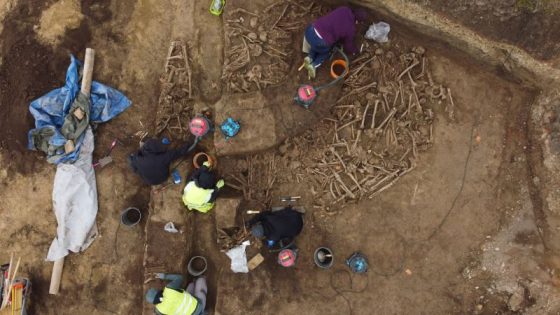The renovation of a football pitch in Vienna, Austria, has led to the discovery of a Roman mass grave containing the remains of over 150 soldiers who died in combat. The find was made in late October 2023 by a construction company working in the Simmering district, with excavations conducted by archaeologists from the Wien Museum.
- Roman mass grave discovered in Vienna
- Remains of over 150 soldiers found
- Evidence of combat-related injuries identified
- Artifacts include iron spearheads and armor
- Discovery linked to Germanic wars of Domitian
- Ongoing research will include DNA analysis
According to the Vienna Department of Urban Archaeology, the remains of at least 129 individuals were uncovered, but the total number is estimated to exceed 150 due to previous construction work that displaced bones. The skeletal remains suggest a chaotic burial, indicating a catastrophic military event.
The excavation revealed that the remains were predominantly male, aged between 20 and 30, and most were over 1.7 meters tall. The skeletal analysis indicated that all individuals had sustained injuries consistent with combat, including wounds from weapons like spears and swords. The burial site showed signs of a hurried covering, with bodies found in disarray, suggesting a rapid retreat following a battle.
Among the artifacts discovered were iron spearheads and pieces of scale armor, which were typical of the period. The remains date back to approximately 80 to 230 AD, a time when whole-body burials were rare in Roman territories, making this find particularly significant. The presence of a cheek piece from a Roman helmet and hobnails from military footwear further supports the military context of the burial.
Experts believe this mass grave is linked to the Germanic wars fought by Emperor Domitian between 86 and 96 AD. Historical records indicate that costly battles occurred during this period along the Roman Empire’s northern Danube border. This discovery provides tangible evidence of these conflicts, which were previously known only through written sources.
Kristina Adler-Wölfl, head of the Vienna Department of Urban Archaeology, emphasized the importance of this find, noting that it offers a rare glimpse into the military history of the Roman Empire. The initial investigation will be part of a broader international research project, including DNA analysis to learn more about the soldiers’ lives and conditions.
This discovery not only sheds light on the Roman military practices but also highlights the significance of Vienna’s historical development from a military outpost to a prominent urban center. The findings will contribute to a greater understanding of the region’s archaeological landscape and its historical narratives.
































